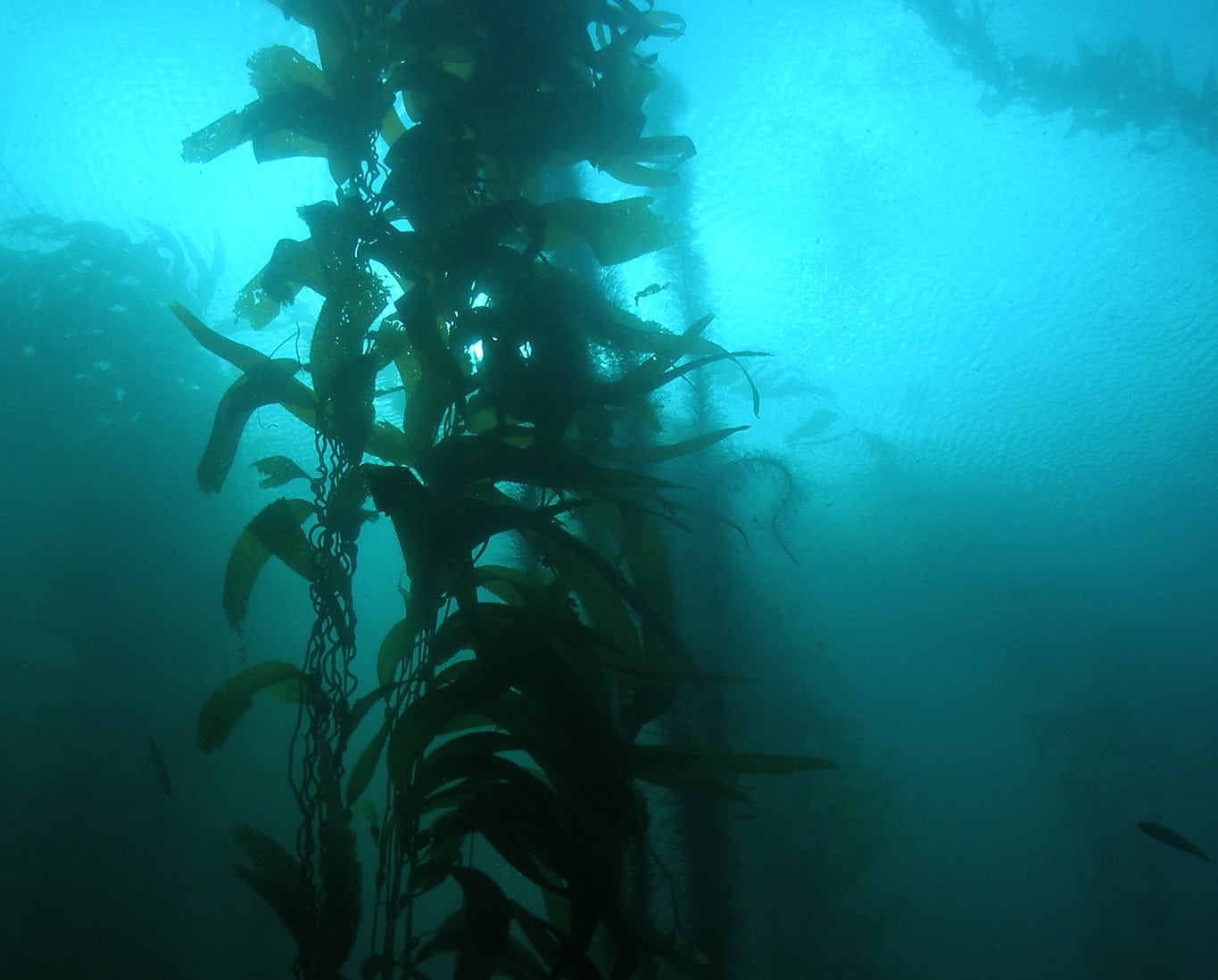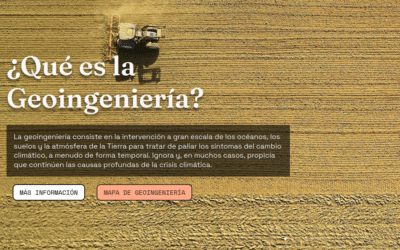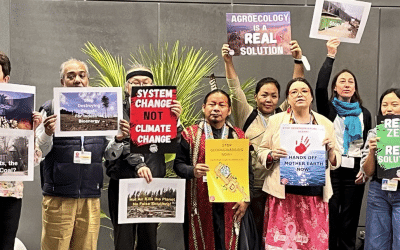This update on Marine Geoengineering through biomass sinking summarises the latest developments on the Geoengineering Monitor Map, highlighting new trends for civil society and climate justice movements to follow in their efforts to oppose geoengineering globally. This update is Part Two of a three-part update on Marine Geoengineering, also covering Ocean Alkalinity Enhancement. It was researched and written by Anja Chalmin, and published with the support of the Geoengineering Monitor team.
In this Geoengineering Map update:
- Critical developments in Marine Geoengineering through biomass sinking
- Biomass sinking: Questions over impacts on deep-sea environments are being ignored
- Recent developments in biomass sinking projects globally
Critical developments in Marine Geoengineering through biomass sinking
- Dumping biomass (referred to as “biomass sinking”) such as wood or seaweed into marine environments as a way to sequester carbon is increasingly seen as a viable climate mitigation strategy, even though many questions about the ecological impacts of it remain unanswered.
- Numerous companies are claiming that they can guarantee that the carbon they sink will remain in the deep sea for hundreds or thousands of years, but these claims are not supported by current scientific research.
- Biomass sinking projects are increasingly moving from the testing phase to commercialisation and becoming more extensive, such as Seaweed Generation Ltd, which has signed carbon offset contracts to sink 50,000 tonnes of biomass, and Seafields Solutions Ltd, which is planning a 6,000 square kilometre seaweed farm.
- A large number of projects are already selling carbon credits through biomass sinking projects, and the revenues that can be generated in this way are a major incentive for these schemes.
- Running Tide Technologies Ltd recently sank 1,000 seaweed-covered buoys in exchange for carbon credits it sold to Shopify, despite the fact that the European Commission has said that the “Science is not robust enough for blue carbon credits to be extended to seaweed ecosystems and seaweed farming.”
- The scale of the potential negative impacts caused by biomass sinking projects are highlighted by the concern that biomass decomposition on the seafloor could result in the release of methane, a greenhouse gas that is 84 times more potent than CO2 over a 20-year timescale.
Biomass sinking: Questions over impacts on deep-sea environments are being ignored
A growing number of companies are dumping seaweed and terrestrial biomass (such as wood) into the ocean so that it and the carbon it contains sinks to the ocean floor. Increasing numbers of projects are sinking biomass in this way on a commercial scale, despite fears that this will negatively impact ocean ecosystems, biogeochemistry and marine food webs, especially if carried out on a large scale.
Biomass sinking is being marketed as a Carbon Dioxide Removal (CDR) strategy, and companies are claiming that they can sequester carbon long-term in order to generate carbon credits. Numerous companies and projects promise that the carbon they sink will remain safely on the seafloor for 1,000 years or more, including:
- Carboniferous Inc: “Effectively 100% of the biomass carbon that reaches the deep basin is trapped for at least 1,000 years“;
- Phykos PBC: “We cultivate seaweed and sink it deep in the ocean, […] safely sequestering excess carbon for 1,000 years or more“;
- Running Tide Technologies Inc: “Storing carbon in the deep sea for hundreds of years“;
- GigaBlue Ltd: “Carbon removal by Gigablue is verified to remain chemically and physically stable in its bio-natural form for over 1,000 years“;
- Brilliant Planet: “The CO2 buried in our dry biomass is highly stable. Each tonne sequestered remains stored for well beyond 1,000-years.“;
- Arbon Earth AB: “Binding the carbon to the deep sea floor for hundreds to millions of years“;
- Rewind: “Stored on the bottom of the sea, the carbon will be sequestered for thousands of years“.
However, recent research suggests that these claims are unfounded, and highlights environmental concerns such as the lack of knowledge about the impact of these schemes on deep-sea ecosystems, and the fact that it is not known how seafloor microbial communities will react to large amounts of biomass being dumped. These concerns are especially true of projects planning to sink biomass on a larger scale. As only 5% of the seabed has been explored by humans, it is impossible to have a full understanding of or to effectively monitor the potential impacts of these projects on deep sea environments.
In addition, companies growing and dumping seaweed cannot guarantee that it will not spread further, for example after storms. This could lead to seawater oxygen depletion and acidification, especially in coastal areas, and favour the spread of fast-growing, invasive seaweed species such as Sargassum spp. Another unanswered question is whether large-scale seaweed cultivation will deplete nutrient reserves for other marine life.
A recent study in the journal Nature Communications Earth & Environment estimated that it would take about one million square kilometres of the most productive ocean regions, an area the size of Ethiopia, to grow enough seaweed to remove one gigaton of carbon from the atmosphere each year. Outside of the most productive marine waters this area would need to be tripled. Such large amounts of seaweed would have a high nutrient demand, which could negatively impact ocean ecology and marine food chains, such as the growth of phytoplankton. Reduced phytoplankton productivity due to nutrient depletion would in turn mean less carbon could be sequestered in the ocean through natural processes.
Other recent publications have cast further doubt on biomass sinking as a climate mitigation strategy. For example, the European Commission’s Blue Bioeconomy report (2023) concluded that “Seaweed sinking for carbon sequestration purposes so far has no proof of positive environmental, climate or economic benefits. Hence, in the present state of knowledge, it should not be considered as a valid policy option […] Science is not robust enough for blue carbon credits to be extended to seaweed ecosystems and seaweed farming.”
In the same year, the UNEP Seaweed Farming report (2023) found that “Seaweed farming has various environmental risks, including competition with wild habitats for nutrients and light, spillover of diseases and invasive species and genetic pollution from farms to the environment, and entanglement of marine megafauna from seaweed farming infrastructure such as ropes.”
Recent developments in biomass sinking projects globally
Seaweed Carbon Solutions: A joint industry project off the coast of Norway
Seaweed Carbon Solutions is a three-year joint industry project led by the Foundation for Industrial and Technical Research (SINTEF) in Norway. The project aims to verify the CO2 removal potential of seaweed, monitor environmental impacts and optimise seaweed cultivation strategies, yields and harvesting technology. In 2023, kelp seedlings were grown in laboratories and sown onto ropes, and their cultivation began in November off the coast of Trøndelag, near the island of Frøya at Storflua in Frohavet. The 20 hectare offshore farm consists of a network of 55 kilometres of kelp lines anchored to the seabed. The first harvest will take place in the summer of 2024, and the harvested seaweed will be sunk to the seabed at depths of more than 1,000 metres or turned into biochar. Biochar production is energy intensive, and the seaweed must first be transported onshore and dried prior to pyrolysis, where it is burned at around 600°C in an oxygen-free environment. The pyrolysed seaweed will be mixed with composted seaweed and soil and tested as a soil amendment. SINTEF estimates that a kelp farm of one square kilometre can yield 20 tonnes of kelp per year, equivalent to three tonnes of CO2. There are plans to expand the farm to 65 hectares by 2030.
Running Tide Technologies Inc: Sinking buoys and selling carbon credits despite unproven concept
This US-based company sinks terrestrial and algal biomass and the carbon it contains into the deep ocean and sells carbon credits for doing so. Basketball-shaped buoys are made from terrestrial biomass (wood), coated with calcium carbonate (CaCO3) and seeded with seaweed such as kelp. The buoys will initially float on the surface of the ocean as the seaweed grows, and the alkaline CaCO3 will dissolve, increasing the alkalinity of the ocean. In theory, after about three months, the seaweed will become too heavy and the buoys will sink, taking the seaweed with them to the ocean floor.
Running Tide Technologies Inc. is headquartered in Maine, and has raised more than US$ 70 million so far. It is also selling carbon credits generated through the biomass it sinks, despite the concerns that have been raised about the potential impacts of its scheme on marine ecosystems. The company is carrying out tests in a number of locations:
Cascadia Basin: Tests in the Cascadia Basin are being conducted in partnership with Ocean Networks Canada (ONC) at ONC’s NEPTUNE seafloor observatory at the Clayoquot Slope site, off the Canadian west coast, at a depth of around 1,250 metres. This initial test will run for one year and aims to investigate what happens to the sunk biomass and the potential impacts it has on the deep-sea environment at this site.
Fram Strait: Another biomass sinking test is taking place in the Fram Strait area of the Arctic Ocean, about 150 kilometres west of the Svalbard archipelago. The rate of degradation of terrestrial and algal biomass on the seafloor will be assessed at a depth of 3,483 metres. The study is being conducted at the Alfred Wegener Institute’s (AWI) Hausgarten observatory in collaboration with Seafields Solutions Ltd, and the research team plans to return in the summer of 2024 to deploy a device which will capture images of the sunk biomass and take samples.
Iceland: Running Tide operates an office in Reykjavik, a macroalgal research site in Akranes and a buoy processing and deployment site in Grundartangi. In 2023, the company was granted a four-year open-ocean testing permit to sink 50,000 tonnes of biomass off the Icelandic coast and 450,000 tonnes in international waters. In the same year, 1,000 tonnes of CaCO3-treated wooden buoys were sunk off the Icelandic coast to fulfill part of a carbon credit purchase by Shopify. Where and when biomass will be sunk next has not yet been publicly announced.
Portland, USA: The company is conducting pilot biomass sinking tests with seaweed in Casco Bay off the coast of Portland and neighbouring communities.
Phykos PBC: Solar-powered seaweed farming and dumping
Californian company Phykos PBC has developed a solar-powered robotic vessel that trails seaweed lines underneath it, and is selling carbon credits based on the amount of seaweed it sinks. Once the seaweed has been planted on the lines the vessel navigates out into the open ocean, and is controlled by software to avoid areas such as shipping lanes. According to Phykos, the vessel has a mechanism to harvest the kelp, which is expected to sink naturally. The vessel also has a scale to weigh the seaweed after each harvest to calculate the amount of carbon that has been sunk. A prototype vessel is being tested in the Pacific Ocean.
Arbon Earth AB: Sinking bamboo and seaweed in the Atlantic
This Swedish company aims to sink terrestrial and algal biomass to the deep ocean and sell carbon credits in the process. It produces “oceanpods” made of bamboo, rope and seaweed. Seaweed-seeded ropes are attached to bamboo pods and released into the sea, where they are expected to sink onto the seabed after several months of seaweed growth. According to the carbon market Onsets, the company is sinking biomass in the Atlantic Ocean, and Arbon Earth mentions a collaboration with the University of the Azores, based in the Portuguese archipelago, but there is no public information on the exact location and scale of the project.
King Tide Carbon Canada Ltd: Growing and sinking kelp in the Gulf of Maine
This company aims to work with seaweed producers to grow algal biomass and sell carbon credits. The harvested seaweed (kelp) will be processed into biochar or dumped in the deep ocean. In 2023, the company entered into a joint venture with Springtide Seaweed LLC, a seaweed producer in the state of Maine, USA. Under the terms of the collaboration, Springtide will be primarily responsible for growing and harvesting the seaweed, while King Tide will be mainly responsible for quantifying the amount of carbon captured and selling carbon credits. Springtide’s seaweed production site covers 22 hectares and is located in Frenchman Bay, in the Gulf of Maine.
Seafields Solutions Ltd: Thousands of square kilometres of sargassum farms
This UK-based company plans to cultivate fast-growing and invasive Sargassum spp. in the open ocean, press it into bales and sink it into the deep ocean in order to sell carbon credits. To feed the farmed seaweed, nutrient-rich water will be pumped from deep waters to the surface through pipes that are several 100 metres long. The company has been testing seaweed farming, farming equipment, biomass degradation and artificial upwelling in the open ocean at several sites since 2021, including off St. Vincent and the Grenadines, the coast of Mexico, in the Fram Strait and off the southern coast of the UK.
The company plans to scale up its activities as soon as its revenue streams through selling carbon credits and seaweed-based products such as plant fortifiers are established. These plans include:
- In 2024, it intends to conduct a one-year trial in the Caribbean, northwest of Isle à Quatre, an island between St Vincent and Grenada, which aims to confirm operational and commercial viability, finalise its carbon credit methodology and conduct an environmental assessment.
- By 2025, Seafields plans to have three commercial farms in the Caribbean and, by 2030, up to 100 farms in the region, covering 6,000 square kilometres of ocean.
- From 2026, the company plans to establish a “Giga Farm” in the South Atlantic Gyre, which will consist of modular farm components covering an area of approximately 95,000 square kilometres.
Seafields provides no information on the potential impact on the marine environment of its scheme, and has not released any details on the types and quantities of equipment that will be used.
UC Santa Barbara: Baling kelp biomass or pumping it to depths of 50 to 100 metres
Scientists at the University of California Santa Barbara and partner institutions are investigating how to sink kelp in the deep ocean, what will happen to it and the likely effects on marine ecosystems. Four methods of sinking are being evaluated: (1) Releasing the biomass into the ocean (“natural sinking”); (2) Shredding the biomass and releasing it to sink naturally or pumping it to depth; (3) Pumping the biomass to depths of 50 to 100 metres where hydrostatic pressure is expected to maintain sinking; and (4) Baling the kelp and sinking it. Methods (3) and (4) are being tested in the Santa Barbara Channel, off the coast of California in the Pacific Ocean. UC Santa Barbara is also conducting a two-year project to investigate methods for Ocean Alkalinity Enhancement with alkaline rock in the laboratory and in mesocosms in the Santa Barbara Channel.
SOS Carbon: Collecting seaweed using boats
Sargassum Ocean Sequestration of Carbon (SOS Carbon), a Massachusetts Institute of Technology spin-off, is seeking to commercialise an approach to collecting and sinking free-floating brown sargassum algae before it reaches Caribbean beaches, using a manually-operated device called the Littoral Collection Module (LCM). The LCM consists of long tubular nets attached to a hoop that is used to collect seaweed and can be attached to small boats. Fifty or more nets can be filled and then transferred to a larger boat, after which the sargassum is transported to an area of deep water and pumped to a depth of 150 to 200 metres. At this depth the seaweed is compressed by the pressure of the water and, once released, is expected to sink to the seabed. SOS Carbon aims to sell carbon credits based on the biomass it sinks, but it is also proposing to harvest the sargassum in order to sell it, or to tow it into ocean currents that will wash it into the open ocean instead of reaching land.
Seaweed Generation Ltd: Developing a seaweed collecting and sinking robot
This UK-registered company has developed a robot, AlgaRay, which collects sargassum seaweed, submerges it to a depth of 200 metres and releases it. The technology was tested off Antigua and Barbuda in 2023, but no information has yet been released on the number, duration and scale of the tests. The company is already generating revenue from selling carbon credits on several carbon markets and has announced plans to sink 50,000 tonnes of sargassum in 2024. According to press reports, Seaweed Generation has been granted a 49-year licence for trials in Antigua and Barbuda. Whether or not this includes commercial sargassum sinking is not yet publicly-known. A report by the Antigua News Room and comments made on the article suggest that the tests have not been well communicated, and that there are concerns regarding the long-term impacts on the biodiversity of the seabed, which are shared by researchers.
Carboniferous Inc and Rewind: Biomass sinking in anoxic areas of the ocean poses serious risks
The Californian company Carboniferous Inc and the Israeli company Rewind are both planning to dump agricultural and forestry biomass on a large scale in anoxic areas of the ocean (areas depleted of dissolved oxygen), and generate carbon credits from the process. Carboniferous Inc is particularly interested in the Orca Basin in the Gulf of Mexico, and Rewind in the Black Sea. Both companies are currently conducting tests to determine the rate of decomposition of biomass such as hardwoods, sugar cane bagasse, corn stalks, leaves and straw.
Rewind is already selling carbon credits, but researchers point out that “research is urgently needed to better understand potential biomass degradation rates and the mixing and transport of degradation products.“ They also highlight gaps in knowledge about potential environmental risks, and potential impacts if the method is applied on a climate-relevant scale. Methanogenic metabolic processes are also cited as a potential risk, whereby organisms that don’t require oxygen release methane when they break down biomass, a greenhouse gas 84 times more potent than CO2 over a 20-year timescale. High rates of biomass decomposition can also add thermal energy to the anoxic water layer, potentially altering water stratification and leading to the release of greenhouse gases. How microbial communities will respond to a significant increase in biomass availability is also unknown. In the Orca Basin, for example, the biomass is to be sunk to depths of more than 2,000 metres—once there, it can only be removed with great difficulty.
Carboniferous Inc: The company plans to collect biomass and transport it to a collection point, prepare it for further transport (shredding and/or briquetting), load it onto a barge on the Mississippi River for transport to the Orca Basin, and dump it into the ocean approximately 130 kilometres south of Louisiana at a water depth of 2,400 metres. Carboniferous’ claims about the stability of carbon in biomass are contradictory. On the one hand, the company claims that “Effectively 100% of the biomass carbon that reaches the deep basin is trapped for at least 1,000 years,” and on the other hand it states that it is researching “how long will the carbon in that biomass be contained” and “replicating anoxic conditions in the lab [to gain] an accurate understanding of how biomass behaves in anoxic conditions.”
Rewind: The company is already generating carbon credits by dumping agricultural and forestry biomass onto the Black Sea seabed, arguing that “in anoxic waters, plants decompose extremely slowly, effectively storing the carbon much longer” and claiming that “stored on the bottom of the sea, the carbon will be sequestered for thousands of years.” In 2022, Rewind started testing its proposal in the Sea of Galilee in Israel, Selker Noor in Germany and the Black Sea off Trabzon, Turkey. It is using different types of biomass, placing them on the seabed for up to 12 months and comparing the dry weight before and after. According to a press report, Rewind plans to transport the biomass to rivers that will carry it to the Black Sea. The company plans to “sequester 50 Mt of carbon in the Black Sea and other locations along the coast of Georgia, Turkey, Bulgaria, and Romania.”
GigaBlue Ltd: Large investments in ocean fertilisation with no environmental impact assessment
This Israeli company plans to release nutrient-enriched particles into the ocean to attract phytoplankton and stimulate plankton growth. After two weeks the particles and the phytoplankton that has accumulated on them are expected to sink into the deep ocean. The company claims that the carbon will reach a minimum depth of 1,000 metres before the aggregates can be consumed by other organisms in the marine food chain, and that the carbon will remain at depth for over 1,000 years. GigaBlue Ltd provides no evidence to support these claims or information on the composition of the nutrient-enriched particles, and an independent environmental impact assessment of the scheme has not been carried out. However, detailed plans are already in place to distribute the particles in partnership with shipping companies, and to sell carbon credits. The company describes its approach as a “breakthrough,” but the concept of adding nutrients to a substrate to fertilise the ocean is not new, having been developed 10 years ago in Australia, for example. Investors have already poured at least US$ 2.5 million into the company, without knowing whether the concept is feasible or its likely impacts on marine ecosystems.
BlueGreen Water Technologies: Using pesticides to generate carbon credits
This Israeli company is planning to sell carbon credits by sinking harmful algal blooms, and has worked in several freshwater locations. It now plans to expand its operations to ocean areas where it will deploy algicides to eliminate algae, including copper sulphate, aluminum sulphate and sodium percarbonate. The latter releases hydrogen peroxide when it comes into contact with water which, according to the European Chemical Agency, “is harmful to aquatic life with long lasting effects.”




